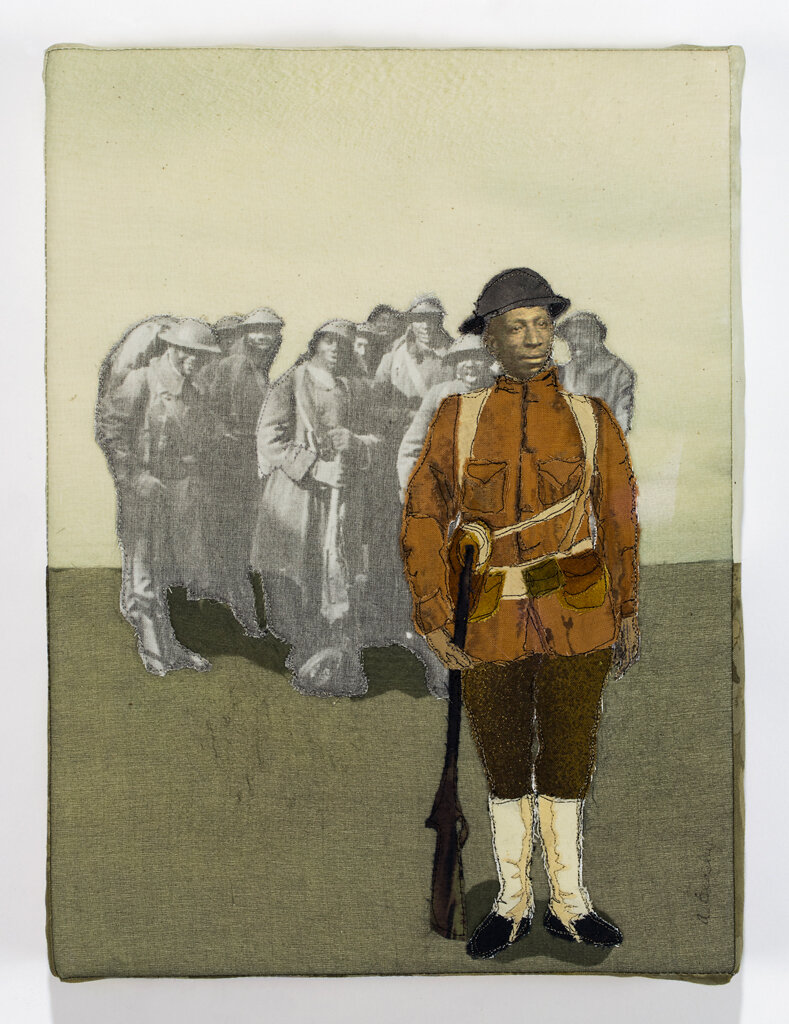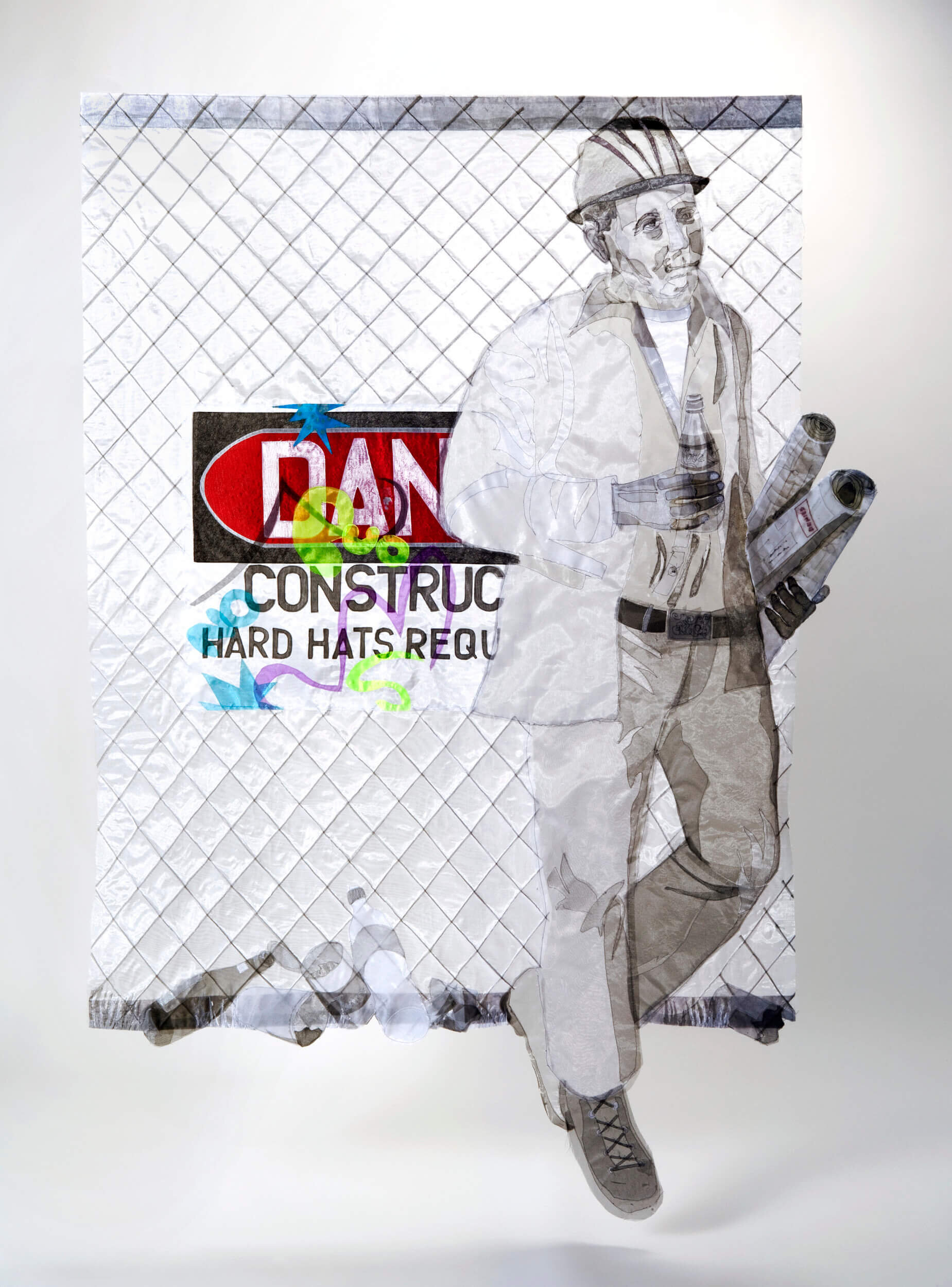FEATURED ARTIST OF THE MONTH
DECEMBER 2020
alice beasley
ALICE BEASLEY
Blood Line (detail), 2015
Fabric composition composed of digitally printed cotton, silk, and polyester
27 in. x 192 in.
Photo Credit: Sibila Savage
artist statement
I have been making portraits of people and objects since 1988. Fabric is my chosen medium of expression through which I incorporate the same light, shadow, and realistic perspective used by artists in other media. Rather than using paint, dyes or other surface treatments, however, I rely instead on finding color, line, and texture in the print of commercial fabric and thread or in fabrics that I print myself. I work directly — gradually building a composition in the same manner as a painter working on a canvas — cutting all pieces freehand from fabric and then machine appliquéing them.
My subject matter is primarily the human figure and the intricate web that plays out as we bob and weave in community with each other. In my studio, I distill what I see into portraits of everyday living in a multicultural world. The contrast of showing deep emotions through a “soft” medium such as fabric can catch viewers by surprise. As one reviewer described it, “…it [is] the details in the needlework, the subtle patterns in the fabric that are so haunting.” Ultimately my goal is to celebrate the human condition in work that both intrigues and inspires the viewer.
Bio
Alice Beasley has exhibited at institutions throughout the United States, including the de Young Museum (San Francisco), the Textile Museum (Washington, DC), the American Folk Art Museum (New York), and the Smithsonian’s Anacostia Community Museum (Washington, DC). Her work has been shown internationally in Madrid, France, Japan, Namibia, and Croatia, and has been purchased or commissioned by a number of public entities including the City and County of San Francisco, the de Young Museum, the United States Embassy, the County of Alameda, Kaiser Hospital, Highland Hospital, and the Sunnyvale Medical Facility.
ALICE BEASLEY
Leaving Home, 2016
Fabric composition composed of silk and cotton
10 in. X 8 in.
Photo credit: Sibila Savage
My great aunt Azalea (who my mother called “Aunt C” because she couldn’t say “Z”) shown leaving her home in Memphis to settle in Detroit, circa 1915. My mother’s family were early entrants in the Great Migration from the Jim Crow South in search of a new freedom in the North.
ALICE BEASLEY
Doughboy, 2016
Fabric composition composed of silk and cotton
12 in. x 9 in.
Photo credit: Sibila Savage
My great uncle Edgar Edmund as a World War I soldier. During WWI, one million African-Americans (Including Edgar) received draft notices, and some 370,000 were inducted into the army. Having seen a vision of a life outside of the color bar, these returning soldiers were the initial impetus for the Great Migration of African-Americans out of the Jim Crow South.
ALICE BEASLEY
Mama, Me and the ’41 Ford, 2016
Fabric composition composed of digitally printed silk and cotton
12 in. x 9 in.
Photo credit: Sibila Savage
My mother’s migration story was more complicated than some. As a baby she moved from Memphis to Detroit with her parents, sister, aunts, and uncles. She grew up in Detroit but when the Depression came she took a job with the VA Hospital in Tuskegee, Alabama. This hospital was constructed in 1923 with the purpose of providing care for the black veterans of World War I — care denied them at most other veteran facilities in the Jim Crow South. But because it was segregated, it also provided a harbor of employment for black professionals such as doctors and nurses. Along with the Tuskegee Institute, founded by Booker T. Washington in 1881, Tuskegee came to be seen as a mecca of black achievement. My parents met at the VA, then married and had two children there in Tuskegee. Four years after I was born, we all climbed into this 1941 Ford and headed north to live in my mother’s hometown, Detroit — migrants once again.
ALICE BEASLEY
Blood Line, 2015
Fabric composition composed of digitally printed cotton, silk, and polyester
27 in. x 192 in.
Photo credit: Sibila Savage
ALICE BEASLEY
Contemplating the Next Move, 2015
Cotton and silk quilt
47 in. x 29 in.
Photo credit: Sibila Savage
ALICE BEASLEY
Stay Strong, 2017
Digitally printed silk and cotton on stretcher bars
30 in. x 24 in.
Photo credit: Sibila Savage
ALICE BEASLEY
Feeding Time at the Swamp, 2017
Digitally printed silk and cotton
60 in. x 48 in.
Photo credit: Sibila Savage
ALICE BEASLEY
No Hard Hats Required, 2012
Silk and polyester organza fabric
70 in. x 48 in.
2012
Photo credit: Sibila Savage









